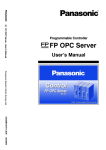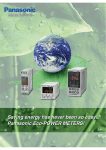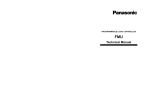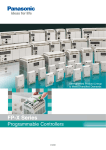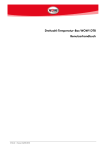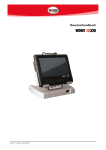Download Laser Marking a user guide for non engineers
Transcript
Laser Marking a user guide for non engineers SUNX Laser Markers from Panasonic Electric Works Panasonic Electric Works and SUNX In recent years the trend to mark and identify goods using laser marking technology has become increasingly important – especially when traceability is at stake. Laser marker systems in modern production facilities are here to stay. Compared with existing methods, laser markers offer non-contact, non-abrasive marking with superior quality and clear contours, virtually maintenance-free operation and low running costs. Moreover, laser marking systems are purely optical tools that require no additional printing materials such as toner, ink or solvents. The operating environment is also extremely flexible and efficient because laser markers can be easily programmed, thus eliminating time-consuming adjustments required by other marking systems. The Panasonic group of companies taken together comprise one of the world’s largest industrial concerns. Founded almost 90 years ago in Japan, the Matsushita Electric Company has adopted the Panasonic name for many of its international trading operations. In addition, for optical sensing and laser marking technologies the group adopted the brand name SUNX. Sunx has been a pioneer of many sensing innovations for more than a generation. Panasonic Electric Works, within its automation control components and systems activities is able to offer an engineering solution to solve the many complex engineering issues that its customers face globally. SUNX and Panasonic Electric Works Product Range • Pressure sensing • Switches • Relays- Electro-Mechanical, Solid State, PhotoMOS • Timers, Counters • Connectors - Micro Miniature and Standard • Programmable Controllers (PLC) • Photoelectric Sensors • Inverters • Colour Mark Detectors • Human – Machine Interfaces (touch panels) • Fibre Optic Sensors • Servo Drives • Laser Markers - CO2 and • Vision Recognition Systems FAYb types • Code Readers - Bar Code, 2D, Datamatrix etc This guide has been published to help non engineers gain an insight into the technology of laser markers. With all of the expertise of Panasonic Electric Works and Sunx, it is also to illustrate how, after a mark is made, using the combined resources of products from both brands, the Company is able to help the user to detect and verify the mark and/or whatever data that mark or code may contain within the manufacturing and logistics processes. Using its UK laser evaluation laboratory Sunx/Panasonic is pleased to assess any given work piece or manufacturing process to establish if laser marking is feasible in the laboratory and to suggest how that mark could be achieved consistently within the manufacturing or assembly environment in which the product is manufactured. Readers are invited to submit samples for evaluation of laser marking capability. Index What is a Laser? 4 What is a Laser Marker? 4 Advantages of Laser Marking 5 What is the meaning of LMP? 5 FAYb - Recent Developments 5 How is the Mark made? 5 Advantages of Laser Marking 7 Simplicity of Programming 8 Working “on the fly” 8 How is the Laser Beam positioned? 11 Health & Safety 11 Accident Policy 12 Fume Extraction 12 Financing 12 Feasibility Studies 12 Marking and processing Laser Markers 13 Laser Marking on Metal 13 Laser Marking on Resins 14 More Questions? 14 What is a LASER? In 1958 two separate teams, one at Columbia University and another at Bell Telephone Laboratories, were working independently and each came up with the concepts that were later developed to become known as the LASER (Light Amplification by Stimulated Emission of Radiation). A LASER light source can have various properties that are designed to meet the needs of the end application. Typically a LASER emits a narrow, low divergence beam that is set at a defined wavelength. In contrast, the light from an incandescent light bulb is emitted over a wide angle (depending on the bulb shape it may be considered as more or less spherical) and in a wide-wavelength spectrum. The physics of laser technology is highly complex and it is not for this simple guide to go into such detail. For in-depth discussion the user is referred to one of the many sites available on the internet. The wavelength of the LASER is determined by an active ‘medium’. The medium can be selected from a range of materials, each having differing properties to set the desired qualities of the LASER. Typical mediums for “solid state“ lasers are elements such as Yttrium that is incorporated with Aluminium Garnet in a crystal form and is commonly known as YAG. Some of the latest developments in LASER technology are using Ytterbium (Yb) as their medium, whilst other technologies incorporate gas, such as Carbon Dioxide (CO2), Helium-Neon or some other substance. What is a Laser Marker? There are a huge range of laser devices on the market, ranging from simple “pointers” to sophisticated devices for medical procedures. In industry there are some very high powered lasers for welding and cutting, whereas others consume just a few watts. Laser Markers incorporate a relatively low powered laser device that, depending on the surface characteristic of the work piece selected, can affect that surface by some form of reaction. This is typically due to a heating effect on the material that is generated at the ‘tip’ of the focused beam. Power is focussed at the ‘tip’ as seen in this laser beam profile of the Sunx FAYb Laser Marker Advantages of Laser Marking The advantages of Laser Marking depend on many factors, such as the existing method of marking (inkjet, tamp print, labels, etc) and the application itself (high speed, complex, time to mark, material etc). It can also depend on what is of most importance for the end customer to achieve from the mark (high quality mark, permanent coding, etc). Laser marking is one of the few methods of marking that creates a permanent mark, which is fast becoming a legal requirement in areas such as food & drink, pharmaceutical and automotive industries. Inks that claim to be ‘permanent’ can still be removed given enough time and determination by the experienced counterfeiter. Marking with a laser is environmentally friendly as there are no solvents or inks required and the systems can have a very low power consumption. What is the meaning of LMP? Some Laser Markers can be used to precision cut certain thin materials, such as some plastics and cabling, and thus the abbreviation LMP is often used, which stands for Laser Marking and Procesing. FAYb - Recent Developments Recent developments include the use of fibres (as in fibre optics) that are sometimes described as FAYb (Fibre Amplified Ytterbium). This is a development by Sunx that took the ageing YAG technology and enhanced it to become the foremost technology in Laser Marking. By utilising fibre technology, the lifetime of the laser medium is greatly enhanced to typically 30,000 hours marktime and 70,000+ hours lifetime. The beam is also better focussed inside the fibre and gives superior marking quality when compared with YAG or CO2 Laser Markers. FAYb technology also requires lower power consumption than YAG lasers, which is good for helping the environment and reducing energy bills. How is the Mark Made? There are various ways in which a Laser Marker can create a mark; Raster Marking, Mask Marking and Vector Marking. Raster Marking This is a similar principle to a dot matrix printer, except using lasers to create the mark. It can be used in very high speed applications, requiring text only (no images/ logos) where high quality of marking and lots of text is not important. Raster Marking Mask Marking A laser beam is directed over a fixed template that is ideal for repetitive marking where the settings do not change on a frequent basis. This has a very short marking time but has major limitations due to its inflexibility. Mask Marking can be quite an expensive method of Laser Marking, as the template needs to be designed, created and replaced with each adjustment to the marking parameters. Mask Marking Vector Marking This is the most common method of laser marking. The laser beam is directed by two mirrors that are controlled via a high speed galvanometer driver. The beam is focussed onto the workpiece by an optical lens and mirrors that are controlled by a sophisticated computer programme. The light beam position and focus can be changed to meet the demands of the user, enabling straight and curved lines to be accurately marked. This is the most flexible method of marking and can solve applications in virtually every industry that requires date codes, bar codes, 2D codes, RSS/GS1 codes, logos and virtually any other desired mark or shape. Adjustment of the software is easy and switching to a new code for marking can take just seconds. Vector Marking Laser Marking Methods There are many different methods that can be employed in order to create a mark on a workpiece. Some materials can be marked by engraving only, whereas with other materials there can be a choice of method to be employed. Melting and Thermal Gouging Changes the surface material with extreme heat, thus changing the reflection of the surface. Annealing or ‘Black Marking’ Encourages a modification to the microstructure of titanium and some steels, creating a permanent (up to 200 degrees Celsius) non-destructive mark. Some times creates a colour change in the material (e.g. green, blue or red tinted marks in stainless steel) Engraving (Deep Marking) Penetrates the surface of the material to ‘cut out’ the desired mark. In glass material, micro-cracks are created that can only be seen under a high powered microscope. Internal Foaming and Carbonisation To create a colour change on some plastic materials, tiny ‘bubbles’ are generated just under the surface to make the mark. Bleaching and Changing Colour A non-destructive interaction with the molecules on the surface of the material occurs creating a colour change. Removing Covering Layer For example, on a label the laser would remove the coating on a printed area and expose the underlying material, thus making a good contrast for the mark. Transferring Material An extra material (special ink, label, etc) is applied to the material by the power of the laser beam. An experienced Sunx Laser Marker Applications Engineer can advise on what marking methods are applicable and best suited to your application and create various marks on your samples so you can decide your preferred method of marking. Simplicity of Programming As in most aspects of life, experience and training are fundamental to achieving an ideal outcome. With Laser Markers from Sunx, the design engineers have been able to utilise their many years of Laser Marking experience and incorporate it into a very sophisticated, yet simple-to-use software program that is easily accessed using either the inbuilt software, a personal computer or a hand held touch screen interface panel. The user can input almost any shape, design, logo, number, letter style or code into the software and position it easily for quick programming. Using the experience of previously developed and perhaps similar markings, the laser power can be set along with scan speed and many other variants, and after (usually) only a few test evaluations, a mark of the highest quality is obtained. In many applications, once the system has been set up by the machine supplier/installer there will be no need to change the marking parameters for many thousands of hours. In sequential marking (such as with expiry dates or item numbering) the machine can be programmed to automatically make the necessary updates without user intervention. However should subsequent events prove that human intervention is needed, the password protected software can be accessed with ease and changes made with minor disruption to the production line. The easy-to-program Sunx Laser Marker NAVI Software can be programmed remotely on a PC and quickly uploaded into the Laser Marker system. In the unlikely event of a problem with programming, the saved file can be e-mailed to the UK based Sunx Laser Marker Technician who can check the file remotely and e-mail the updated file to the on-site engineer for uploading into the system thus quickly making it ready restart marking. All settings that can be adjusted in the software can also be programmed and sent to the system using the RS232 protocol via a PLC. Working “on the fly” Sunx Laser Marker systems are capable of marking on production lines that move at up to 240m/min (depending on the application). Using an inbuilt encoder interface it is a matter of ease to integrate such high speed operations so that the laser is triggered and makes the mark precisely where it is needed every time. Laser Marking is rapidly becoming the preferred option for high speed bottling lines (glass, PET) and packaging (cardboard, plastic, metal). Often when operating at speed an inkjet printer nozzle will clog up or spray ink when and where it is not needed – a problem that is immediately eliminated when using Laser Marking. There is also no downtime for maintenance to replace inks or solvents or unclog nozzles. Once setup, the Laser Marker will mark at the same consistently high quality at high speed for many thousands of hours without the need for adjustment. Example of a Laser Marked Code by a Sunx Laser Marker at a Line Speed of 240m/min Cooling Demands The power of Laser Markers is much lower when compared with that of cutting/welding lasers, but even so, significant heat can still be generated by the lasing medium. With some YAG Laser Markers it is necessary to incorporate sophisticated water cooling equipment into the overall system to help dissipate the heat that is generated by the medium. Due to the nature of lasers, there is usually a low efficiency power conversion within the laser components. Advances in fibre technology for Laser Marking have overcome the need for expensive water cooling systems. In the Sunx LP-V FAYb Laser Marker Series, the fibre inside the controller is 50 metres long and the consequently large surface area this provides means that air cooling is sufficient. A system that is air cooled requires no consumables or maintenance. Beam Quality One of the most significant features of any Laser Marker is the quality of the focused beam at the work surface. This is known as M2 and in the ideal situation M2 should be as close to 1.0 as possible. Sunx FAYb Laser Markers have an M2 rating of 1.4 (LP-W model has M2 = 1.1) and therefore capable of producing some of the best quality marking from industrial use lasers. A typical YAG laser has an M2 rating of 20.0. The difference between FAYb and YAG is the way in which the laser beam is produced. FAYb is produced in ‘single-mode’ whereas YAG is ‘multi-mode’. This high quality beam factor means that using FAYb technology from Sunx the user will see a much higher quality marked image on his work piece, yet at a lower power consumption. The difference between SUNX FAYb single mode and YAG multi-mode laser beams Operational Life and Maintenance Sunx FAYb Laser Markers are able to achieve a marking life of in excess of 30,000 hours. That implies about 3.5 years of continuous, 24 hours per day marking without the need for maintenance. With some other technologies, such as YAG, the marking life is more or less synonymous with the operational life – implying that the life of the laser will begin to be used up even when the laser is active, but not marking. A typical diode-pumped YAG laser will have a lifetime and marktime of 14,000 hours. The 30,000 hour marktime figure quoted by Sunx implies that the operational life of the SUNX FAYb device is much greater than that of any other commercially available Laser Marker. Sunx CO2 Laser Markers can run for min. 12,000 hours, typically more than 24,000 hours of marktime with minimal need for maintenance other than making sure the lens is kept clean from environmental dirt and dust. Apart from the moving galvanometers of the laser beam focusing mechanisms and the fans for air cooling, there are no moving parts within a laser system. With FAYb and CO2 lasers from Sunx there are no consumables, such as de-ionised water, or elements that may require servicing as are common in equivalent YAG lasers. Alternatives to Laser Marking There are potentially many different considerations for the user to make before deciding on using a Laser Marker as their chosen method of marking. The requirements of each application are unique, and the user must decide upon many factors before committing to any method of marking. Typical alternatives to Laser Marking include: • Ink Jet printing • Tampo Printing • Chemical Etching • Adhesive or Other Label • Sand Blasting Consumables With few, if any, consumables (depending on the laser technology selected) Laser Marking is increasingly offering significant user benefits over most other marking methods. However, there are still instances where the use of more traditional marking methods is still the preferred marking option. Similarly, for very high volume repetitive marking, Laser Markers may not always be the most viable option. Laser Marking is increasingly becoming the marking method of choice where flexibility, ease of programming, lack of maintenance, elimination of consumables and high speed/ high quality operation are significant considerations for the end user. 10 How is the Laser Beam Positioned? Setting up and positioning of the work piece can often be problematic. However in a well designed Laser system, it should be possible to use the principle of two converging low power (and safe) lasers that will converge at the point of focus to a sharp, well defined light spot. This is sometimes described as the “Barnes Wallis” effect that was named after the second world war design using lamps at a preset distance from a surface used in the “Dambusters” raid. This ‘pilot laser’ comes as standard with the LP-400 and LP-V/W series of Sunx Laser Markers. It is often an optional extra from other manufacturers. Easy Setting of Work Distance with the Integrated Pilot Light on a Sunx Laser Marker Health & Safety When using any kind of laser in the work environment the user should always be aware of the potential for exposure to an unguarded laser beam. The FAYb and CO2 types supplied by Sunx are Class 4 lasers, which is the standard classification for a Laser Marker. The designer of the installation must ensure that any beam emitted by the laser is shielded or guarded against being reflected. In particular if there is any opportunity for inadvertent direct viewing of the beam by users or passers-by when it is unguarded then the operator and any viewer must wear suitable safety goggles that have been certified for use with the particular laser wavelength that is being emitted. In most cases the Laser Marker will be incorporated into a piece of machinery that is supplied by third parties and it is expected that the machine designer will have taken into account such safety considerations. Such guarding will typically bring the Class 4 laser installation into the Class 1 classification. However, the person or persons ultimately responsible for on-site safety, usually the person in charge of Health & Safety, should ensure that all necessary safety precautions are in place and that they can not be over-ridden except by persons who are trained and qualified to do so. 11 Accident Policy In the event that an accident should occur, the user should have in place a clearly written procedure of how other personnel should react and to where any person who has been exposed to a potentially damaging laser emission should be taken (for example to hospital). Some exposures may cause no damage. Some will cause burning to body tissue. Some may cause blindness to one or another part of the laser-exposed eye that may not be repairable. As with any industrial equipment it is the responsibility of the user’s management to ensure that all appropriate training of personnel is in place and that all appropriate measures are taken to ensure the safety of their staff. This includes when the machine incorporating the laser is in operation, when it is not in operation and particularly when it is being serviced or maintained. Fume extraction Depending on the material to be marked it is probable that one or another chemical in the form of gas, smoke or dust will be released. As with every well designed installation, such pollutants must not be permitted to enter the environment. The provision of a suitable fume extraction device is considered fundamental. That product should be able to filter out even the smallest particles. If needed the exhaust air of such extractors can be vented to the atmosphere external to the building where the machine is installed, but local planning regulations must be a consideration where appropriate. Please ask your local Laser Marker specialist if you need any advice. Panasonic can supply third party high quality fume extractors. Financing The cost of a high quality Laser Marking system is not insignificant. The Laser Marker supplier, although not actually being able himself to act as a financial advisor, should be able to put the user (should he/she so require) in touch with finance institutions that may be able to offer one or another extended period financing option to help defer the cost of purchase. Feasibility Studies Any reputable Laser Marker supplier should be able to test mark a given sample to show the quality of marking from the system. From those samples, the user can determine their preferred style of mark (font, position, colour, depth of mark, etc). Such a Feasibility Study can quickly determine whether a request is viable and if so which system is most suited to the application. With variables such as power, duration, speed, size of the mark, requested mark colour etc., it is useful to be able to call in the expertise of a supplier who will have a wide range of similar marked examples already “tried and tested”. Sunx offer their sample marking service free of charge. 12 LMP fundamentals Laser marking on metal 13 Laser marking on resins More Questions? If you have any further questions about Laser Marking or would like to discuss an application, you can contact the UK based Sunx Laser Marking Team who will be happy to advise on what is, and what is not, possible. For more information contact: Sales & Marketing Manager – Laser Markers Panasonic Electric Works UK Ltd Sunrise Parkway Linford Wood Milton Keynes MK14 6LF Direct Tel: +44 (0)7768 013683 Tel: +44 (0)1908 231555 Fax: +44 (0)1908 231599 E-Mail: [email protected] Web: www.SunxLaserMarkers.co.uk Sales Manager Irish Branch Office Panasonic Electric Works Waverly Old Naas Road Dublin 12 Direct Tel 00353 (0) 879 583385 Tel 00353 (0) 1 4600969 Fax 00353 (0) 1 4601131 Sunx and Panasonic are brand names of Matsushita Electric Works Ltd, of Japan 14 15 Global Network North America Europe Asia Pacific China Japan Panasonic Electric Works Please contact our Global Sales Companies in: Europe Headquarters Panasonic Electric Works Europe AG Rudolf-Diesel-Ring 2, 83607 Holzkirchen, Tel. (08024) 648-0, Fax (08024) 648-111, www.panasonic-electric-works.com Austria Panasonic Electric Works Austria GmbH PEW Electronic Materials Europe GmbH Panasonic Electric Works Sales Western Europe B.V. Panasonic Electric Works Czech s.r.o. Rep. of PEWDE, Josef Madersperger Str. 2, 2362 Biedermannsdorf, Tel. (02236) 26846, Fax (02236) 46133, www.panasonic-electric-works.at Ennshafenstraße 30, 4470 Enns, Tel. (07223) 883, Fax (07223) 88333, www.panasonic-electronic-materials.com De Rijn 4, (Postbus 211), 5684 PJ Best, (5680 AE Best), Netherlands, Tel. (0499) 372727, Fax (0499) 372185, www.panasonic-electric-works.nl Prumyslová 1, 34815 Planá, Tel. 374 799 990, Fax 374 799 999, www.panasonic-electric-works.cz Succursale Française, 10, rue des petits ruisseaux, 91370 Verrières le Buisson, Tél. 01 60135757, Fax 01 60135758, www.panasonic-electric-works.fr Rudolf-Diesel-Ring 2, 83607 Holzkirchen, Tel. (08024) 648-0, Fax (08024) 648-555, www.panasonic-electric-works.de Hungary Panasonic Electric Works Sales Western Europe B.V. Panasonic Electric Works Deutschland GmbH Panasonic Electric Works Europe AG Ireland Panasonic Electric Works UK Ltd. Magyarországi Közvetlen Kereskedelmi Képviselete, 1117 Budapest, Neumann János u. 1., Tel. 06 1 482 9258, Fax 06 1 482 9259, www.panasonic-electric-works.hu Dublin, Tel. (01) 4600969, Fax (01) 4601131, www.panasonic-electric-works.co.uk Italy Panasonic Electric Works Italia s.r.l. Via del Commercio 3-5 (Z.I. Ferlina), 37012 Bussolengo (VR), Tel. (045) 6752711, Fax (045) 6700444, www.panasonic-electric-works.it Panasonic Electric Works Italia s.r.l. Building Materials Division, Piazza della Repubblica 24, 20154 Milano (MI), Tel. (02) 29005391, Fax (02) 29003466 Poland Panasonic Electric Works Nordic AB PEW Fire & Security Technology Europe AB Panasonic Electric Works Polska sp. z o.o Sjöängsvägen 10, 19272 Sollentuna, Sweden, Tel. (08) 59476680, Fax (08) 59476690, www.panasonic-electric-works.se Citadellsvägen 23, 21118 Malmö, Tel. (040) 6977000, Fax (040) 6977099, www.panasonic-fire-security.com Al. Krakowska 4/6, 02-284 Warszawa, Tel. 22 338-11-33, Fax 22 338-12-00, www.panasonic-electric-works.pl Portugal Panasonic Electric Works España S.A. Portuguese Branch Office, Avda Adelino Amaro da Costa 728 R/C J, 2750-277 Cascais, Tel. (21) 4812520, Fax (21) 4812529 Spain Panasonic Electric Works España S.A. Barajas Park, San Severo 20, 28042 Madrid, Tel. (91) 3293875, Fax (91) 3292976, www.panasonic-electric-works.es Switzerland Panasonic Electric Works Schweiz AG Grundstrasse 8, 6343 Rotkreuz, Tel. (041) 7997050, Fax (041) 7997055, www.panasonic-electric-works.ch United Kingdom Panasonic Electric Works UK Ltd. Sunrise Parkway, Linford Wood, Milton Keynes, MK14 6 LF, Tel. (01908) 231555, Fax (01908) 231599, www.panasonic-electric-works.co.uk Benelux Czech Republic France Germany Nordic Countries North & South America USA PEW Corporation of America 629 Central Avenue, New Providence, N.J. 07974, Tel. 1-908-464-3550, Fax 1-908-464-8513, www.pewa.panasonic.com Asia Pacific / China / Japan China Panasonic Electric Works (China) Co., Ltd. Hong Kong Panasonic Electric Works (Hong Kong) Co., Ltd. Matsushita Electric Works, Ltd. Japan Singapore Panasonic Electric Works Asia Pacific Pte. Ltd. Level 2, Tower W3, The Towers Oriental Plaza, No. 2, East Chang An Ave., Dong Cheng District, Beijing 100738, Tel. (010) 8518-5988, Fax (010) 8518-1297 RM1205-9, 12/F, Tower 2, The Gateway, 25 Canton Road, Tsimshatsui, Kowloon, Hong Kong, Tel. (0852) 2956-3118, Fax (0852) 2956-0398 1048 Kadoma, Kadoma-shi, Osaka 571-8686, Japan, Tel. (06) 6908-1050, Fax (06) 6908-5781, www.mew.co.jp/e-acg/ 101 Thomson Road, #25-03/05, United Square, Singapore 307591, Tel. (06255) 5473, Fax (06253) 5689 Copyright © 2007 • Printed in Germany 1151 euen 11/07


















